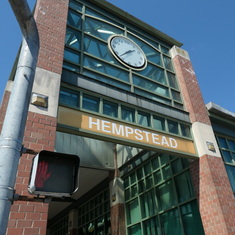
Guide to Long Island - Hempstead
First published: Sunday May 12th, 2024
Report this blog
Introduction
Last week, I visited the county seat of Nassau County: Mineola. Today I'm going just a bit south of Mineola to the village of Hempstead (not to be confused with the Town of Hempstead).
Part I - History and Geography
Just to get one bit of confusion cleared up, I want to quickly distinguish between the Town of Hempstead and Hempstead (village), especially since the terminology is quite confusing. Nassau and Suffolk county are subdivided into sections called "towns". These are not towns in the traditional sense one might think of a town, but rather they encompass large swaths of areas containing many smaller villages, hamlets, and census designated places which are colloquially referred to as towns by locals. In this case, the Town of Hempstead, as shown below takes up a large section of southwestern Nassau and the village of Hempstead is defined by the orange boundary within. Just for the sake of this blog, every mention going forth of "Hempstead" will refer to the village boundaries unless stated otherwise.

Like most of Long Island, modern day Hempstead was briefly colonized by the Dutch with their early settlements in the 1600s. In 1643, two English men named John Carman and Robert Fordham purchased a large amount of land from the local Native American tribes in exchange for various items. The region was named after Hemel-Hempstead, the town in Hertfordshire the two men hailed from. Hempstead experienced a lot of growth in the following years as many English families from Stamford, CT emigrated to establish a prominent community. Throughout the following decades and centuries, Hempstead became one of the most important villages on Long Island as well as a major center of business and commerce. Unfortunately, the village saw major decline during the past fifty years. The rise of post war suburbs and large retail stores devastated the local businesses forcing many of them out of business. The coming years would not be kind for the once booming economy; as crime, poverty, and unemployment took off. Today, Hempstead still suffers from a lot of these issues, as well as an infamously corrupt school system. Hempstead remains one of the poorest parts of Long Island with nearly 18% of the population being below the poverty line; A stark contrast to the very affluent towns of Garden City and Rockville Centre which directly border the village.
Now it's time for some statistics. Per the 2020 census, Hempstead has 53,891 people, making it the second largest village on Long Island, only having less than Brentwood, NY. Hempstead still remains one of the biggest transportation hubs on Long Island, for both NICE busses and the LIRR. It's home to Rosa Parks bus terminal which is right across the street from Hempstead's Long Island Railroad station, the final stop on the self titled Hempstead branch. Hempstead also has several major roads running through the village such as Front Street, Fulton Avenue, and Peninsula Boulevard.
Part II - Exploring Hempstead
Transit Centers
Taking the train to Hempstead will drop you off right in Hempstead's center. Right across is the aforementioned Rosa Parks bus terminal where you can catch a bus to take you pretty much anywhere you want on the island. Unfortunately, Hempstead fails to take full advantage of having such a huge transit center. It squanders a lot of space by having a ton of surface level parking scattered throughout. That being said, I did notice quite a bit of construction projects and new development upon arriving, so hopefully the village can truly maximize its downtown.





Main Street
Going a bit further, we get to walk down some of Hempstead's main streets that were the source of its booming economy back in the day. Unfortunately, those days are far behind as these main streets have seen a lot of decay and neglect. Some parts are also a bit industrial with car service shops, mechanics, and warehouses.







Religious buildings
As a remnant of Hempstead's puritan origins, the town still has a lot of historical churches such as Saint George's Episcopal church and the United Methodist Church of Hempstead.


On the left depicts St George's Episcopal Church as it stood in 1734. However following its destruction, the church was rebuilt in 1822 which still stands today.



Part III - Summary
So that's Hempstead. A town significantly past its prime which has yet to truly rebound to its status as Long Island's prosperous hub. As Im writing this, I kind of get the sense that this one wasn't quite as interesting as some blogs I have planned for the future in this series but I still find places like this important to cover. I plan on depicting just about every aspect of Long Island and I'm not gonna shy away from an area just because it's not as glamorous as the north shore towns or as quaint as some towns on the south shore or the Hamptons. As always, I hope you found this interesting and informative, and join me next time as I visit Sea Cliff (Spoiler: I actually visited it weeks ago, I just have to write up the blog)
